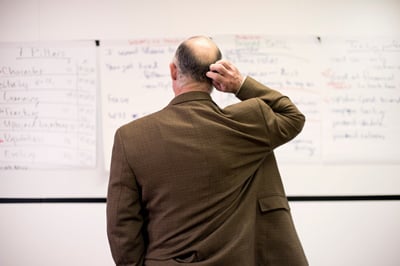by Ken Lopez
Founder/CEO
A2L Consulting
I frequently encounter trial teams that say things like:
- "My client has some graphics capabilities in-house."
- "Our client is a top expert in the field, so they want to explain the technology to the jury in their own way."
- "My client wants to stand up at trial and use a flip chart to explain the science."
I hear these and other similar statements most frequently in patent cases and other science or technology-focused cases. On their face, there's nothing wrong with these remarks. However, sometimes the client's desire to be helpful interferes with the trial team's ability to try the case effectively. I empathize with these litigators. Nobody likes to say "no" to a client, especially when the desire to be helpful is partially motivated by budget concerns.
When I founded A2L nearly twenty years ago, the only meaningful competition we had in the litigation graphics and courtroom animation industries came from engineering firms who also supported trial teams. A2L's offering was very different. We brought artistic lawyers and litigators in to serve as litigation graphics consultants rather than using engineers.
My rationale was simple. Engineers may be very good at illustrating a point, but they are not especially good at persuasively making a point. For that, lawyers were best suited, and they could also rely on engineering, scientific or technical support from the client and experts as needed. Our model became synonymous with what we now commonly refer to as "litigation consulting."
It didn't take too many years before our competition morphed to look at lot like A2L, and those engineering firms eventually faded away. I believe the same principles apply when evaluating how or whether to use litigation graphics consultants when the ultimate client has significant internal expertise, even artistic expertise, in-house.
Just like those engineering firms A2L used to compete with, when support is offered by in-house resources at the client's firm, it is typically highly expert, highly trained and is useful for facilitating the illustration of a point in the courtroom. However, such in-house expertise, mostly scientists, engineers and technology experts, is not normally persuasion-oriented, and this group is almost always unfamiliar with what a fact-finder needs to see in order to find for the client.
In these situations, instead of an ideal client>litigator>expert>litigation graphics consultants>fact-finder flow of information, you end up with a highly imperfect client>expert>litigator>client>fact-finder flow that results in higher costs and worse outcomes. Here are seven reasons I think a trial team needs help from outside litigation graphics consultants no matter what kind of expertise the client's in-house people can provide.
- Well-founded discovery fears: Anytime the client is involved in trial presentation preparations, there is a risk that they will inadvertently generate new evidence that is subject to discovery. Since litigation graphics consultants are working for the law firm, these communications are protected from discovery.
- Storytelling assistance: With storytelling recognized as a serious persuasion tool, it is very helpful to work with litigation graphics consultants like A2L and others who are expert in helping trial teams craft a story. See 21 Reasons a Litigator Is Your Best Litigation Graphics Consultant. No matter how expert a client is in the underlying subject matter of a case, they are not likely also presentation experts, persuasion experts or storytelling experts.
- Fresh set of eyes: This cliché is one of the primary reasons trial teams use litigation graphics consultants at all. When you've lived with something for a long time as a trial team does and as in-house personnel at the client do everyday, it helps to hear how experts like trained litigation graphics consultants approach the same information.
- A forest perspective: Closely related to the fresh pair of eyes concept, a litigation graphics consultant is not burdened with all the details when a case is presented to them. Accordingly, they are able to hear it in a way that is similar to the way a juror will. Usually, neither a trial team nor any one from the client is able to step back far enough to get out of the trees and really see the forest in the same way a jury will.
- Mock trial testing: Firms like A2L are not just litigation graphics consultants, but are instead full-service litigation consulting firms. One key component of a comprehensive litigation consulting firm is the ability to conduct mock trials and provide mock trial analysis of the effort by a Ph.d.-level expert. Obviously, this is not going to be an expertise offered by the client's in-house team. Testing of how a judge or jury will react to a case is critical in large cases as are testing the visuals that will be used. See 7 Reasons In-House Counsel Should Want a Mock Trial and 10 Things Every Mock Jury Ever Has Said.
- Persuasion science is moving fast: Great litigation graphics consultants are experts in the science of persuasion. I suspect this group of people numbers fewer than a couple of dozen people nationwide. Since your goal at trial is to persuade the fact-finders, you really want every persuasion advantage you can find. It is not realistic to expect that you will find this expertise at the client firm or even inside most law firms for that matter. See Could Surprise Be One of Your Best Visual Persuasion Tools?, Font Matters - A Trial Graphics Consultant's Trick to Overcome Bias, 6 Studies That Support Litigation Graphics in Courtroom Presentations, 5 Ways to Apply Active Teaching Methods for Better Persuasion, and 8 Videos and 7 Articles About the Science of Courtroom Persuasion.
- Masters of PowerPoint: A litigation graphics consulting firm can run circles around mere PowerPoint users as one of our most popular articles, 16 PowerPoint Litigation Graphics You Won't Believe Are PowerPoint, and one of our most popular webinars, Using PowerPoint Litigation Graphics for the Win, demonstrate. This kind of work takes real time to develop. Just because a client can generate some imagery does not mean it can generate persuasive imagery or put it together in a way that is going to align with the decisions we're asking our fact-finders to make. At the end of the day, it is not about pictures, it is about presentation, and those two things are entirely different (if you're an expert).
Other articles and resources related to using litigation graphics consultants on A2L Consulting's site:
- Run a confidential conflicts check
- 21 Reasons a Litigator Is Your Best Litigation Graphics Consultant
- Webinar: Using PowerPoint Litigation Graphics as a Litigator
- Webinar: Using Storytelling for Persuasion
- 5 Surprising Areas Where Geography No Longer Matters in Trial Support
- 12 Questions to Ask When Hiring a Trial Graphics Consultant
- 7 Questions Will Save You Money with Litigation Graphics Consultants
- Free Download: Using Litigation Graphics Persuasively
- Free Download: Storytelling for Litigators: Building a Great Narrative for Judge & Jury
- The 14 Most Preventable Trial Preparation Mistakes
- 12 Alternative Fee Arrangements We Use and You Could Too
- 6 Triggers That Prompt a Call to Your Litigation Consultant
- 11 Things Your Colleagues Pay Litigation Consultants to Do
- 16 Litigation Graphics Lessons for Mid-Sized Law Firms






Leave a Comment